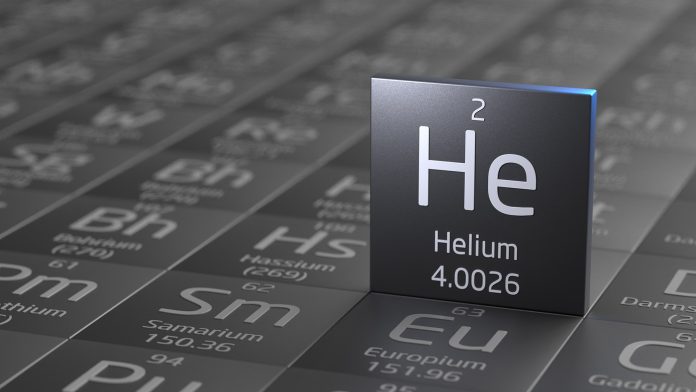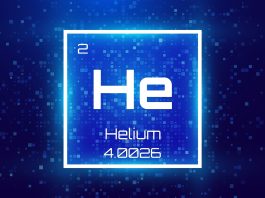Frankie Wood-Black, Division Chair, Engineering, Physical Science and Process Technology at Northern Oklahoma College, explains the history of helium and its exploration in the US and highlights importance of safeguarding this valuable reserve.
Helium is a noble gas with unique properties. It is the second lightest element and possesses the lowest boiling point of any element. Initially discovered on the Sun – earning it the nickname ‘the alien element’ – helium has since been found on Earth in the atmosphere, radioactive minerals, natural gases, and mineral springs.
The discovery that natural gas was rich in helium led to an increased supply, making it indispensable to various industries such as aerospace, technology, healthcare, and manufacturing.
Despite its significance, helium reserves are finite, making it crucial to explore alternative sources and consider sustainable practices to ensure a stable supply for the future.
To provide insight into the history of helium and its many uses, The Innovation Platform Editor Maddie Hall sat down with Frankie Wood-Black.
Can you outline how helium was first discovered?
The 19th century was a time of scientific revolution, with numerous inventions and discoveries. One such invention was the spectroscope, an instrument that dispersed sunlight into measurable wavelengths. This process revealed distinct dark lines amidst the usual colours. Scientists Gustav Kirchhoff and Robert Bunsen noticed that some of these lines corresponded to emission lines observed when heating chemical elements. When atoms are excited, they emit light, creating spectral lines. These lines can be seen as either an absorption spectrum, where specific light wavelengths are taken in by the atoms, or as an emission spectrum, where specific light wavelengths are given off by the atoms. Each element produces a unique set of spectral lines that are key to understanding the chemical composition of bodies like the Sun.
In 1868, during a solar eclipse, a new bright yellow line was detected in the solar spectrum that didn’t correspond to any known chemical element. While a number of scientists noticed this new line, this discovery is attributed to both Pierre Janssen and Norman Lockyer. Bearing a similar set of spectral lines, it was initially thought that this could be sodium. Lockyer, however, believed it was a new element.
Further research led to the identification of helium, named after Helios, the Greek god of the Sun. This marked the first observation of helium, an element that was later found to exist on Earth as well.
How was helium confirmed to exist on Earth?
In 1882, Italian physicist Luigi Palmieri detected helium’s spectral line in lava from Mount Vesuvius. This marked the first discovery of helium on Earth. A more formal discovery came through Scottish chemist William Ramsey’s isolation of helium from the mineral cleveite in 1895. Though helium was clearly present on Earth, at this point, there was no clear idea of how abundant it may be and, therefore, whether it was going to be commercially viable.

This was until the discovery of helium in natural gas wells. During their analysis of a natural gas sample in Kansas, Cady and McFarland identified helium, and lots of it, among the expected gases. Subsequent testing of over 40 other gas samples also revealed an abundance of helium, dispelling the notion that helium was rare on Earth.
Where is helium found on Earth?
Helium is a fascinating element that can be found in small, non-commercial quantities in the Earth’s atmosphere. However, the main commercial source of helium comes from natural gas wells. While these wells are typically sought after for methane and butane as fuel sources, some wells in Western Kansas have been found to contain high concentrations of helium along with other unburnable gases. Interestingly, the helium content in these old natural gas wells has become more valuable than the fuel they were originally intended for.
In the US, helium-rich wells are primarily located in the Texas Panhandle, Oklahoma, Kansas, Wyoming, and parts of Colorado. In Wyoming, helium production has advanced to the point where companies are actively extracting helium directly from gas pockets rather than just considering it a byproduct of natural gas extraction. This process demonstrates the evolving importance and value of helium as a natural resource.
Are current methods of helium extraction sustainable?
Helium is formed by fusion in stars. Hydrogen is compressed, and four atoms combine to form a helium nucleus. This natural process takes place in stars, with intense heat and pressure enabling nuclear fusion. Helium is an abundant element, but it is not always visible because it filters out through the atmosphere.
However, helium is not produced on Earth; it is isolated after being trapped here. As such, helium is a non-renewable resource, which is concerning given that its current extraction rate is fast exceeding its replenishment. This demand shows no signs of slowing, thanks to helium’s versatility. With potential applications in sustainable air transport and energy systems, it is more likely demand will only increase. Therefore, it’s crucial to conserve our helium reserves to ensure a stable supply for future generations.
Helium, being a small and light atom, presents challenges in terms of resource management once it is isolated. Our current abilities to recycle helium are limited. Given the importance of safeguarding the helium reserve, it is crucial to develop innovative solutions that can effectively address the complexities associated with both preserving and utilising this valuable resource.
Traditional helium extraction is sustainable in that the industry has regenerated older oil and gas fields that have been in use since the early 1900s. In some cases, helium production is a byproduct or extension of the fuel industry. However, this gas extraction remains carbon-intensive, and though helium will remain an important resource in the green transition, the same cannot be said for the natural gas and oil fuel sources we are aiming to transition from. If we are to continue relying on helium extraction through traditional methods, it is imperative that we explore and invest in alternative and more sustainable extraction processes.
The presence of helium in the atmosphere is a potential solution, but the concentration is very low, with helium making up only 0.00052% of the atmosphere. The moon is also considered a potential alternative for helium extraction, as it has more abundant helium deposits on its surface, deposited by the solar wind due to the relative lack of atmosphere and magnetic field. Although tapping into lunar helium presents a significant opportunity, there are still challenges related to high costs, technology, and transporting the helium back to Earth.
Nonetheless, it remains a promising option for securing our future helium supply. However, if we are to invest time, research, and resources into exploring lunar helium, it must be accompanied by circular practices that conserve and recycle this non-renewable resource.
Why is helium such a crucial resource, and what are its uses?
Helium is an incredibly versatile resource with applications across medicine, defence, aerospace, and critical infrastructure. Its lighter-than-air, inertness, high thermal conductivity, and low boiling point properties are employed across industries to cool, protect, and lift. Some examples include:
Medicine
Helium plays a vital cooling role in the operation of superconducting magnets, which are integral components of MRI machines and other equipment that necessitate low temperatures. Thanks to its lighter-than-air quality, it can also be used to treat respiratory conditions.

Inflation
Due to its unique properties, helium is frequently used to inflate airships and balloons – including weather balloons. Its low density and non-reactive nature make it ideal for lifting objects, and its non-flammable characteristic distinguishes it from hydrogen.
Semiconductor manufacturing
Helium is used in reactive ion etching in semiconductor manufacturing. It is frequently combined with other gases to produce plasmas and assists in controlling the temperature throughout the process. It can also be used to dissipate heat generated during manufacturing, protecting essential components.
Welding
Helium can be used in welding processes to prevent oxidation and contamination from the atmosphere. It is particularly used in this shielding capacity when welding materials like titanium and aluminium.
Should helium be classed as a critical mineral, and are there efforts to protect and conserve helium?
There are ongoing efforts to conserve helium as a resource. Currently, the US Geological Survey (USGS) is seeking input on whether helium should be reinstated on the critical minerals list. In 2022, helium was removed from the list, indicating that it no longer met the necessary criteria that include supply risk, economic importance, and potential disruptions to supply. Helium’s removal is likely due to the discovery of additional helium deposits.
It is a question of where we are regarding supply versus demand. A decade ago, our known supply of helium was lower, placing it on the critical list. However, the current known supply is higher, suggesting it should be removed from the list. The complicating factor is helium’s non-renewable status. Even though the supply may have increased, the resource remains finite, adding complexity to the debate. Additionally, demand has also increased. In light of recent exploration efforts leading to increased supply, it might be considered an endangered rather than a critical mineral.
In spite of its debated status, efforts remain to conserve and protect the helium supply. In the US, the Bureau of Land Management (BLM) manages the Federal Helium Reserve. Though the reserve is mandated to be slowly privatised, the 2013 Helium Stewardship Act ensured extended government authority to protect and ensure a reliable helium supply.
The US Government regularly assesses the supply and demand of the helium market and adjusts its policies accordingly. While new exploration is supported, there are also efforts to promote recycling in industries with heavy helium use, encouraging programmes that capture and reuse helium. Investment is additionally directed into the development of alternative helium sources and research into new technologies that can improve efficiency.
Ultimately, we must excel in establishing more circular practices. By establishing a robust helium industry that maximises its resources, we can secure a sustainable and reliable supply for years to come.
Please note, this article will also appear in the 18th edition of our quarterly publication.










